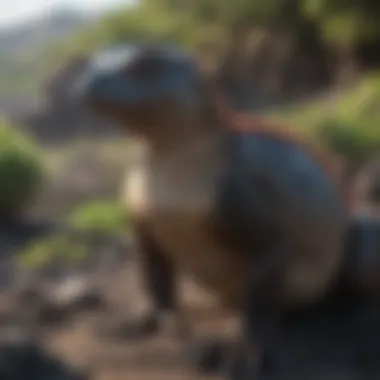Darwin's Journey: Evolutionary Insights from the Galapagos


Intro
The name Charles Darwin often evokes thoughts of evolution, natural selection, and groundbreaking theories in biology. However, one vital aspect of his work that may not always be highlighted is the influence of the Galapagos Islands on his scientific journey. This isolated archipelago, lying about 600 miles off the coast of Ecuador, became a living laboratory for Darwin in the early 1830s. His observations there played a crucial part in the development of his ideas about species adaptation and evolution.
The unique biodiversity of the Galapagos is nothing short of remarkable. Many species found on these islands, such as the famous finches and giant tortoises, exhibit traits specifically suited to their respective environments. These observations sparked a series of profound questions in Darwin's mind, leading him to ponder how such diverse adaptations emerged over time under distinct environmental pressures.
By weaving together the ecological richness of the islands and Darwin’s inquisitive mind, the study of the Galapagos offers more than just a glimpse into the past; it presents a framework for understanding present-day biological science and the ongoing discussions surrounding evolution.
This article aims to highlight key points regarding the historical significance of Darwin's work, the implications of his findings on our understanding of living organisms, and the broader implications for biological research today.
In delving into the research findings and methodologies that have emerged from this pivotal moment in scientific history, we are invited to reflect on the enduring impact of Darwin's expedition and how it laid the groundwork for contemporary studies in evolution.
Preamble to Darwin and the Galapagos
The journey of Charles Darwin to the Galapagos Islands stands as a cornerstone in the annals of scientific exploration and natural history. This section lays the groundwork for understanding the pivotal relationship between Darwin and the Galapagos, setting the stage for how these remote islands ignited the spark of evolutionary theory. By examining the intricate tapestry of biodiversity found on the islands, we will delve into the environmental factors that fueled Darwin's revolutionary insights. These islands, often referred to as a living laboratory, served not just as a backdrop for Darwin's studies, but also as a critical catalyst for his ideas about natural selection and species adaptation.
Understanding this topic is vital, not only for appreciating the legacy of Darwin but also for recognizing the broader implications of his findings in contemporary biology. The Galapagos Islands showcase examples of evolution in real-time, and exploring their significance allows us to witness the ongoing dialogue between nature and science that continues to this day. By critiquing the challenges faced by species due to isolation and considering Darwin's observations, we can better grasp the complexities of evolutionary dynamics.
Overview of Charles Darwin's Background
Charles Darwin was born in Shrewsbury, England, in 1809 into a well-to-do family, which provided him with an education that sparked his intellectual curiosity. From an early age, Darwin showed a keen interest in the natural world, collecting specimens of various plants and animals. However, his formal education in medicine and later in theology did not align with his passion for natural science, prompting him to seek a different path.
In the early 1830s, Darwin’s life took a pivotal turn when he was invited to join the HMS Beagle on its scientific expedition around the world. This voyage, which would last nearly five years, became the lens through which he would observe the mechanisms of nature, setting him on the path that would lead to his revolutionary theories.
The Voyage of the Beagle
The HMS Beagle, a small surveying ship, embarked on its famous expedition in 1831, under the command of Captain Robert FitzRoy. The primary goal of the voyage was to chart the coast of South America, but it became much more than that. Darwin, who served as the ship's naturalist, had the unique opportunity to explore diverse ecosystems, geological formations, and a wealth of wildlife across multiple continents.
The Beagle's journey took Darwin to the Galapagos Islands in 1835, where he encountered various species that would later play a critical role in the development of his theories. Each island in the Galapagos boasted different species of finches, tortoises, and iguanas, adapted uniquely to their environments. This was unlike anything Darwin had seen before, and each observation deepened his fascination with natural history.
His experiences on the islands raised profound questions about how species adapt to their environments and how they could change over generations. The concept of adaptive radiation, where species diverge from a common ancestor, was crystallizing in his mind long before he published his landmark work, "On the Origin of Species."
"Nothing is more easy than to admit and to believe; but the difficulty lies in making the observations and collecting the facts."
— Charles Darwin
This quote encapsulates the spirit of scientific inquiry that characterized Darwin’s work. His time aboard the Beagle, particularly in the Galapagos, was not just a journey across oceans, but an expedition into the heart of biological diversity where he began to untangle the web of life itself.
The Unique Ecosystem of the Galapagos Islands
The Galapagos Islands offer a treasure trove of unique biological and geological features that have captured the attention of scientists and researchers since Darwin’s time. This area is not just a collection of islands. It is a living laboratory where diverse ecological interactions take place. Understanding this ecosystem is crucial since it provides insight into the processes that drive evolution and species diversity. The interplay between the islands’ geographical features and its flora and fauna made it an unparalleled resource for Darwin, and it continues to hold significance for modern science.
Geographical Features and Their Impact
The geographical makeup of the Galapagos plays a pivotal role in shaping the life forms that exist there. Comprising 13 major islands and several smaller ones, the archipelago has been shaped by volcanic activity over millions of years. Each island possesses distinct elevations, soils, and climates, creating varied habitats ranging from arid lands to lush highlands.
These features contribute to the islands' isolation, which in turn fosters unique evolutionary pathways. Take, for example, the highland regions such as the slopes of Sierra Negra on Isabela Island. Here, the wet climate supports a fascinating range of endemic plants and animals. This contrast in terrains allows for different species to thrive, leading to what Darwin observed as adaptive radiation.
- Volcanic Landscapes: The rugged, often harsh surfaces of the islands challenge species to adapt for survival.
- Isolation: Each island functions almost like a separate world, allowing species to evolve independently.
- Microclimates: Differences in elevation and exposure create varied weather patterns, influencing plant and animal life.


The importance of these factors cannot be overstated, as they serve as a natural experiment demonstrating how isolation and environmental pressures catalyze evolutionary processes.
Flora and Fauna Found in the Islands
The richness of biodiversity in the Galapagos is staggering. The islands are home to a plethora of species found nowhere else on Earth. This is largely due to their remote position in the Pacific Ocean and the unique set of conditions each island presents.
Flora: From the giant tortoise to an array of succulent plants, the flora has adapted to the islands' challenging environments. The famed Charles Darwin’s finches, which are often cited as a cornerstone of his observations, exhibit variations in beak size and shape that correspond directly to the food sources available on their specific islands.
Fauna: The islands boast an impressive array of animal life.
- Marine Iguanas: The only lizards that can forage in the ocean, showcasing adaptability.
- Galapagos Hawks: These predatory birds are a testament to the delicate balance of the ecosystem.
- Blue-footed Boobies: Known for their quirky mating dance, which is also influenced by their isolated breeding sites.
"The isolation of the Galapagos Islands create a unique environment for evolution. Only there can you find species that have adapted in ways seen nowhere else."
The diverse biota on the Galapagos isn’t just an impressive display of nature; it serves as a rich context for understanding evolution. Each species occupies a niche that demonstrates the incredible adaptability of life. The collection of species, whether they be plants or animals, all interact symbiotically, contributing to the islands’ vitality.
In summary, the Galapagos Islands’ unique ecosystem inspires an ongoing investigation into the mechanisms of natural selection. It reveals how geographical features and shared evolutionary paths create a complex tapestry of life, thirsty for exploration.
Darwin's Observations in the Galapagos
Darwin’s time in the Galapagos Islands was critical not just for him personally but also for the world of biology. These islands, with their unique geographical configurations and diverse ecosystems, served as a living laboratory, where Darwin observed the interplay of species and their environments. His observations laid the groundwork for what would later be articulated in the theory of evolution.
One can hardly overstate the impact of Darwin’s findings during this journey. Many species on the islands exhibited distinct variations that were not present in similar species on the mainland or other regions. These anomalies led Darwin to ponder deeply the nature of species variation and drove him towards the beginnings of his theory about natural selection.
Species Variation and Adaptation
The Galapagos Islands were a microcosm of evolution in action. The finches, famously dubbed "Darwin's finches," displayed an astonishing variety in beak shapes and sizes. Each species of finch adapted to the specific food sources available on its respective island—one had a beak suited for cracking seeds, while another was perfect for snatching insects. This kind of adaptation suggested that these birds evolved from a common ancestor but diverged based on the ecological niches they occupied.
This led Darwin to consider the following points:
- Natural Variation: Individuals within a species had variations, some of which provided advantages in survival and reproduction.
- Selection Pressure: Environmental challenges such as food scarcity or predation shaped these variations over generations.
- Adaptative Radiation: New species emerged as finches migrated to different islands, adapting to unique environmental conditions.
"It is not the strongest of the species that survive, nor the most intelligent, but the one most responsive to change."
Darwin's keen observations were not restricted to finches. He noted variations among tortoises as well, which had developed unique shell shapes based on their island habitats. These differences in form and function showcased how species can adapt to specific environments, underscoring the interplay between morphology and ecology.
The Role of Isolation in Evolution
The Galapagos Islands are a classic study in isolation, which is a crucial element of evolutionary theory. The geographical separation of these islands allowed species to evolve independently from the mainland. This isolation led to unique evolutionary paths, contributing to biodiversity.
For example:
- Limited Gene Exchange: With species isolated on individual islands, there was less genetic mixing with mainland populations, allowing distinct traits to develop.
- Adaptive Isolation: Each island presented specific challenges and resources, further driving the adaptive changes noted earlier.
- Founder's Effect: When few individuals from a species migrate to an isolated area, the genetic diversity is limited, which can lead to rapid evolutionary changes over time.
The observations made by Darwin in such isolated environments demonstrated how geographical separation can lead to significant evolutionary changes. His innovative approaches to understanding these phenomena were groundbreaking and set the stage for future research in evolutionary biology.
In summary, Charles Darwin’s meticulous observations in the Galapagos not only revolutionized the understanding of species variation and adaptation but also illuminated how isolation can sculpt the evolutionary narrative of life on Earth.
The Inception of Natural Selection


The concept of natural selection stands as a cornerstone in understanding evolutionary biology. It is a principle that explains how species adapt to their environments over generations. For Darwin, this framework was more than an abstract theory; it was the lens through which he started to understand the diversity of life he encountered during his famous voyage. The Galapagos Islands served as a natural laboratory that showcased the phenomenon of evolution in vivid detail.
Defining Natural Selection
Natural selection can be seen as the process where organisms that are better adapted to their environment tend to survive and produce more offspring. In simplistic terms, it’s survival of the fittest. But that phrase can be misleading. It refers not just to strength but to a complex interplay of traits that confer advantages in specific conditions.
Darwin articulated this idea while observing various species in the Galapagos. Take, for instance, the finches. Each island hosted finches that had different beak shapes suited to their available food sources.
- Large beaks were ideal for cracking tough seeds on islands where those were prevalent.
- Smaller, pointed beaks adapted to extracting insects from bark.
These observations spurred Darwin to ponder how these variations arose and how they played a role in survival. The critical takeaway here is that natural selection is not a purposeful act or guided process but rather an outcome of environmental pressures and genetic diversity.
Evidence Drawn from the Galapagos
Darwin's data from the Galapagos islands provided empirical grounding for his ideas. The variability he noted was not a mere coincidence but a reflection of the islands’ isolation and the selective pressures inherent within their ecosystems. In essence, the Galapagos presented a scenario where isolation allowed for unique adaptations to flourish, making these islands exemplary models of natural selection.
Consider these pivotal aspects of evidence:
- The Marine Iguanas adapted to swim and forage in the ocean, shedding many terrestrial traits that were not beneficial in their new aquatic habitat.
- The various tortoise species on different islands showcasing distinct shell shapes, enabling them to reach different types of vegetation.
These instances highlighted a clear pattern that adaptations arise in response to environmental contexts, echoing Darwin's foundational principle that these traits improve an organism's survival and reproductive success.
"It is not the strongest of the species that survive, nor the most intelligent, but the one most responsive to change."
The inferences drawn from Darwin's Galapagos expedition laid the groundwork for a revolutionary outlook on biological diversity. His insights didn’t just contribute to biology; they sparked discussions across disciplines, from philosophy to sociology, on the implications of change, adaptation, and survival in a world where everything is not set in stone but is, in fact, malleable and dynamic.
Understanding natural selection provides a significant advantage not only in grasping evolutionary theory but also in addressing modern scientific inquiries related to genetics, biodiversity, and conservation efforts today.
Impact of Darwin's Work on Science
Darwin's work fundamentally reshaped the landscape of biology, providing a well of insights that continues to inform and influence various scientific fields. Its impact is not only confined to academic circles but extends into the broader fabric of society and culture. Understanding how Darwin's ideas intermingled with science reveals much about the evolution of human thought and our grasp of life itself.
Influence on Evolutionary Biology
Darwin's theory of natural selection birthed a paradigm shift in evolutionary biology. Before his time, many held onto creationist views, seeing species as fixed entities. In contrast, Darwin illustrated that species were dynamic, constantly adapting to their environments. His observations in the Galapagos played a significant role in this.
Consider the finches as a prime example: the variations in their beaks made clear that even similar species could diverge significantly based on their ecological niches. Each finch type developed unique beak shapes suited to different food sources, showcasing how environmental pressures could guide evolutionary change.
Furthermore, Darwin painted a framework within which evolutionary biologists could operate, allowing them to build upon his foundational concepts. His ideas sparked further research, inspiring generations of scientists to explore genetic variations and the mechanisms of inheritance that govern both adaptation and speciation. Today, we recognize his work as not just a stepping stone but as a catalyst for ongoing discoveries in molecular biology and ecological genetics.
Cultural and Societal Implications
Darwin's legacy transcends textbook chapters; it has carved itself into the consciousness of many cultures worldwide. His theories stirred up discussions that rippled through religion, philosophy, and politics. The idea that species, including humans, evolved over time was a coin that flipped traditional views on creation and our place in the universe.
"Darwin’s revelations led to a broader questioning of established beliefs, prompting society to reevaluate its understanding of life and morality."
In the realm of society, Darwin's work ignited heated debates between science and religion. From the courtroom battles like the Scopes Trial in the United States to various secular movements, the conversation surrounding evolution has challenged individuals and communities to reconcile faith with scientific understanding.


Moreover, the cultural impacts are felt in literature, art, and psychology, influencing how we view progress, diversity, and the human condition itself. This interplay between Darwin's scientific contributions and their societal implications reflects a profound legacy that continues to evolve as new discoveries emerge.
The influence of Darwin's work on science, then, cannot be overstated; it's a testament to how one person's observations can reshape entire fields and challenge societal norms. As we further probe the depths of biology and philosophy, Darwin's insights remain a compass guiding our pursuit of knowledge.
Modern Research and the Galapagos
The Galapagos Islands continue to be a focal point for scientific inquiry, contributing significantly to our understanding of evolution and ecology. Modern research in this unique archipelago is pivotal not only for the study of Darwinian principles but also for comprehending the intricate dynamics of ecosystems. This section navigates through current studies on species adaptation and the ongoing conservation efforts that strive to protect this vital natural laboratory.
Current Studies on Species Adaptation
The rigorous investigations into species adaptation within the Galapagos have blossomed since Darwin's time. Today, researchers employ a variety of methodologies ranging from field studies to advanced genetic analyses, each aiming to shed light on how organisms thrive in their particular environments. Some areas of focus include:
- Genetic Variation: Scientists are mapping genomes of various species, such as the finches that so fascinated Darwin. By pinpointing genetic variations, researchers can better understand how specific traits enhance survival and reproduction in distinct habitats.
- Phenotypic Changes: Researchers observe physical changes in response to environmental pressures. These changes can be critical indicators of adaptive responses, revealing how species adjust their physiology or morphology in real-time.
- Invasive Species Impact: Studying how native species manage to coexist with or compete against invasive species has become a pressing area of inquiry. Understanding this dynamic is crucial for predicting future ecological shifts.
These studies not only augment our historical knowledge but also equip conservationists with essential data to create effective management strategies for local wildlife.
Conservation Efforts in the Islands
The Galapagos Islands, while magnificent, face numerous threats including climate change, invasive species, and tourism pressures. Therefore, conservation efforts are vital to safeguard the unique biodiversity they harbor. Various initiatives can be outlined:
- Protected Areas: The government has established national parks and marine reserves to create safe havens for endangered species. These protected areas are carefully monitored by ecologists and rangers to ensure compliance with conservation regulations.
- Community Engagement: Local communities play a pivotal role in conservation. Programs promoting sustainable practices help bridge the gap between conservation needs and local economic activities. Engaging the community fosters a sense of ownership and accountability over natural resources.
- Research and Monitoring: Ongoing research is critical in assessing the health of ecosystems. The Galapagos Conservancy and other organizations work tirelessly to study species populations, climate change effects, and habitat restoration progress.
- Education and Awareness: Educating both locals and visitors about the ecological significance of the Galapagos is essential. Awareness campaigns highlight the unique biodiversity and the actions individuals can take to minimize their impact, encouraging more sustainable tourism practices.
"The ultimate aim of conservation is not to protect nature for its own sake, but to ensure its enduring presence for future generations."
Through these efforts, scientists and conservationists alike are ensuring that the legacy of Darwin's discoveries continues to thrive in the Galapagos. The ongoing research and conservation initiatives paint a vivid picture of the islands’ ecological complexity and their relevance to evolutionary theory today.
The End: The Legacy of Darwin's Work
Charles Darwin's contributions to science are like ripples on a pond; they extend far beyond the moment they are made, reaching various facets of knowledge and understanding. The legacy of his work is particularly significant in the context of evolutionary theory and the broader implications for biology as a whole. Not only did Darwin introduce concepts that reshaped scientific thinking, but he also initiated profound discussions that continue to influence various disciplines today.
One key element of his legacy is the refinement of the theory of natural selection. Through the observations he made in the Galapagos Islands, Darwin articulated ideas that provided a framework for future research into evolutionary biology. Natural selection is not merely a historical concept. It acts as a lens through which modern biology examines species adaptation and environmental interactions.
Additionally, Darwin’s findings have was not limited to academic discourse. His theories sparked cultural discussions that probe into humanity's place in the natural world. It challenges the narrative of creation versus evolution that remains relevant in educational and religious debates. Understanding this interplay gives insight into how deeply Darwin's ideas have penetrated societal norms and values.
Through ongoing research and advancements in genetics, Darwin’s work has been the seed from which many scientific advancements have sprouted. The integration of genetics and evolutionary theory has opened up new frontiers of understanding, leading to novel research avenues such as evolutionary developmental biology.
Enduring Relevance in Scientific Discourse
The relevance of Darwin's work cannot be overstated. In scientific circles, the principles established by Darwin serve as the backbone of evolutionary studies. The scientific community continues to refer to his findings when exploring questions of species divergence, adaptation, and the hereditary aspects of traits.
Moreover, his work lays the groundwork for contemporary research into biodiversity, conservation, and ecology. For example, studies on climate change impact directly relate back to concepts Darwin rooted in his observations—the adaptability of species in response to environmental shifts.
"Darwin's insights are still a valuable compass for understanding complex biological phenomena and their implications for both nature and humanity."
Moreover, in education, Darwinian principles are part of curricula in biology classes, reinforcing their significance for upcoming generations who will carry forth this knowledge. This continuous endorsement is a testament to how vital Darwin's ideas remain in teaching and understanding biological sciences.
Reflections on Evolutionary Theory Today
In today's context, evolutionary theory is not static. It has grown and adapted, reflecting advancements in technology and shifts in scientific perspectives. Darwin’s original ideas have undergone scrutiny and expansion, incorporating modern genetic knowledge and even molecular biology.
People are often surprised at how relevant Darwin’s work is to today’s problems. For instance, his concepts play a crucial role in understanding antibiotic resistance and how pathogens evolve in response to medical intervention. This highlights that the principles of evolution are not just historical phenomena but active processes influencing our health and well-being.
Furthermore, as we face issues like climate change and habitat destruction, the evolutionary frameworks first laid out by Darwin offer insights into how species might adapt—or fail to adapt—to rapidly changing conditions. The world is observing not just natural selection but also human-driven selection, altering the genetic make-up of species, which may have profound effects on biodiversity moving forward.
In sum, the legacy of Darwin’s work continues to be a vibrant part of scientific inquiry, societal discussions, and educational frameworks. His insights into natural selection and adaptation haven’t just withstood the test of time; they’ve evolved and inspired an entire field dedicated to understanding life in all its complexity.



